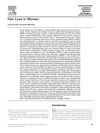Androgenetic Alopecia: Pathogenetic Mechanisms and Treatment Approaches
January 2013
in “
Российский журнал кожных и венерических болезней
”

TLDR Androgenic alopecia, a common hair loss condition, is linked to changes in androgen metabolism and genetics, and can be treated with finasteride and minoxidil, but these treatments are only fully effective in 10% of patients.
The 2012 document "Androgenic Alopecia: Pathogenetic Mechanisms and Therapeutic Approaches" discussed the causes and treatments of androgenic alopecia, a common form of hair loss. The condition was linked to changes in androgen metabolism, genetic predisposition, and high serum levels of free testosterone. The most effective treatments at the time were finasteride and minoxidil, with promising results from botuloxin A and platelet-rich plasma therapies. However, these treatments were only effective in 10% of patients. A study of 1879 patients showed that 66% experienced hair regrowth and 83% saw a halt in hair loss after 2 years of using finasteride. Other treatments included botulinum toxin type A, which stopped hair loss in 39% of 50 patients, and platelet-rich plasma, which activated growth factors leading to hair follicle regeneration. The document also reported a study on the effect of intradermal injections of group B vitamins and Cystin B6 complex on patients with diffuse alopecia, which improved circulation, promoted the recovery of the natural hair growth cycle, and inhibited hair loss. Despite these treatments, none were deemed fully effective, indicating a need for new treatment approaches.





